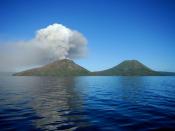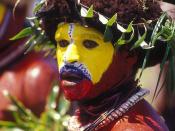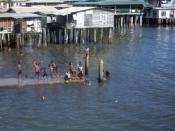(Historical, Cultural And Spiritual Overviews)
Land Of Lost Tribes And Languages
Few people who follow the torturous exploits of the Portuguese who circumnavigated the globe half a millennium ago ever reach The Molucca Islands tucked away in the Indonesian archipelago. These islands, reached by Jorge de Menses in 1526, are still largely unknown even to geography-literate people in the West.
De Menses landed on the shores of Wageo island, which he promptly named Papuwah (later to become Papua) which is a Malay word meaning "fuzzy" or "frizzled Hair."
Nueva Guinea was the nickname given the island by Inigo Ortiz de Retes in 1545 because of the striking resemblance of the fuzzy headed natives to those of the African colony of Guinea. Consequently, this newly discovered territory of Guinea-like warriors became known as New Guinea.
On July 1, 1971, four years prior to their actual independence, the eastern half of the island officially became recognized as Papua New Guinea.
Geography And Climate
Fiercely rugged is the island of New Guinea! The north is divided from the south by massive mountain ranges whose razor edge ridges and jagged peaks protrude as a spiny backbone throughout the length of the island. Towering Alps of more than 14,000 feet are separated by deep jungle ravines and cavernous gorges that explode with rivers swollen by tropical rains. Coral reefs visible through the pristine, aqua blue water, inhabit the lagoons. Endless acres of coconut groves are interspersed with miles of virginal jungle rain forests, expansive grasslands, savanna swamps and mist-shrouded mountain ranges. Wisps of smoke from widely scattered villages fill the skies in every direction from trail to horizon. Rough, mountainous terrain is the prevalent physical feature of this defiant land. Only the trans-Fly flatlands in the Western Province are without mountainous countryside. It is...



GOOD
AN ESSAY WITH STRONG ARGUMENTS AND SMOOTH PATTERN.
0 out of 0 people found this comment useful.